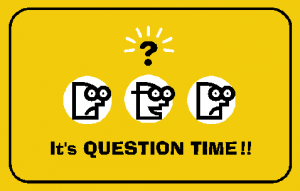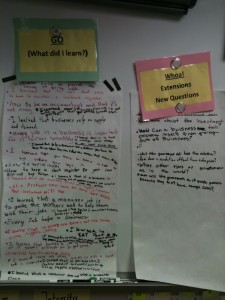Create a Culture of Questioning and Inquiry

I have often suggested to teachers that when students have access to technology, whether it is provided by the school in a 1:1, BYOD, or simply the smart phone in their pocket, there should never be a question that goes unanswered –or un-followed. These are teachable moments for how to effectively search for information (information literacy & digital literacy) and allowing the time for students to explore connected ideas brings more depth to the learning, and allows students to make sense of things as they combine new information what they already know and understand, as well as to identify misunderstandings. Questioning leads to synthesis. It also makes the learning personal for students.
What I discovered in the 300+ observations I have done for our 21st Century Learning grant work was that the problem isn’t necessarily about allowing time for students to answer questions. The problem is that they rarely ask questions beyond simply clarifying what needs to be done for the assignment. Something happens to the majority of students after the primary years – and the questioning process seems to give way to compliance. “Tell me what I need to do to get an A.” (…or just to get a passing grade, as the case may be)
As the new school year begins, think about how you might begin to shift from a culture of compliance, to a culture of questioning in your classroom. Here are a few ideas that you might introduce at the beginning of the year.
Ask: “What do you wonder?”

This seems like a simple thing to do – and it is! One idea is to use current events as a springboard for questioning. Rather than ask students to write a summary of a current event (or in addition to) – ask them to write down the questions that popped in their head as they were reading. A great tool to collect these questions, besides using chart paper & post-it note is Lino-It. Follow up the questioning activity with time for students to investigate and seek answers!
Question wall

I found these in several classrooms I visited recently. Sometimes this might take to form of a KWL chart. Most teachers are familiar with KWL: What do you Know, What do you Want to Know, and What did you Learn. My suggestion is you add an “I” to the chart –for “What will You Continue to Investigate?” While these are not always expressed as questions, it still gets back to the concept of getting kids in touch with their curiosity.
Tools and ideas to transform education. Sign up below.
Question journal
Get students in the habit of collecting questions in a journal – paper or electronic. Evernote would be a great tool for this with the ability to add multiple tags. Students record questions as they occur, and share them during a designated class time, allowing the teacher to model how to go about seeking answers. This would be a great way to start helping students with information literacy skills.
Question Formulation Technique

I was excited to attend a workshop last year sponsored by Colorado Metro State’s Teaching With Primary Sources program and delivered by The Right Question Institute where we learned how to use The Question Formulation Technique (QFT) strategy to teach students how to question. The process is simple and available online – however I encourage you to get their book Make Just One Change: Teach Students to Ask Their Own Questions for more in-depth ideas how to use the strategy. An elementary TAG teacher I work with recently used the QFT with her 5th grade students following a Human Body Unit. They filled up 2 chart paper sheets full of questions that they still had – even when the unit had ended! What a great opportunity for extending the learning in the direction of the student’s own area of interest!
Inquiry days
Building on the idea of Genius Hour or 20% Time –perhaps some students would relish in the opportunity for “inquiry days.” The student would assume the role of Content Curator and, after deciding on a question they are passionate about answering, begin pursuing answers. This needs to be free from formal grading, but formative assessment of the 21st century skills are a must!
Here are 3 of my favorite books to help get you started with creating a culture of inquiry & questioning in your classroom:
Learning to Question, To Wonder, To Learn by Jamie McKenzie
Q Tasks, by Carol Koechlin and Sandi Zwaan
Make Just One Change: Teaching Students to Ask Their Own Questions, by Dan Rothstein & Luz Santana
cross posted at cross posted at Innovations in Education
Nancy White is the 21st Century Learning & Innovation Specialist for Academy School District 20, providing professional development on 21st century skills and technology integration, and working with the IT-ES team to carry out the district’s 21st Century Learning Plan. Nancy served on an ad-hoc team to help with the integration of 21st century skills into Colorado’s revised content standards, and co-authored The Colorado Learner’s Bill of Rights. Read more at Innovations in Education.
